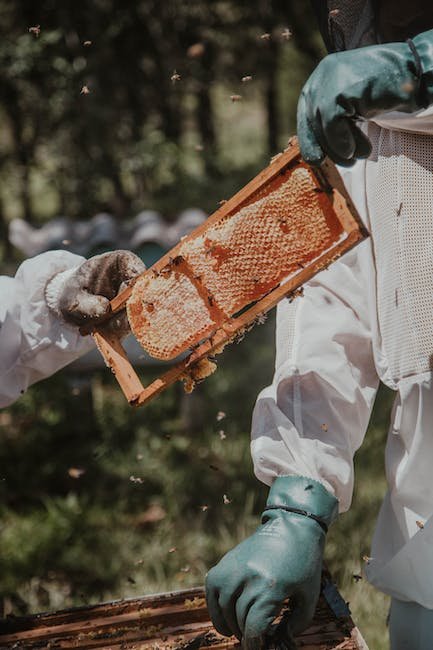Beneath the golden rays of the sun, a secret world silently thrives amidst nature’s gentle embrace. Where flowers bloom and fruits entice, busy pollinators buzz to the rhythm of life, orchestrating a delicate dance that sustains our ecosystems. Perhaps you too have been captivated by the enchanting buzz of these remarkable creatures, yearning to venture into the realm of beekeeping. But fear not, for this clandestine pursuit is not reserved for the chosen few. With determination and a thirst for knowledge, you too can embark on this remarkable journey. In this step-by-step guide, we unravel the mysterious process of obtaining a beekeeping permit and unlock the gates to the ancient art of beekeeping. So, put on your protective veil and join us as we delve into the world of bees, honey, and the path to becoming a certified beekeeper.
Table of Contents
- Setting Up Your Beekeeping Operation
- Navigating the Beekeeping Permit Process
- Understanding the Legal Requirements
- Preparing Your Beekeeping Equipment
- Submitting Your Beekeeping Permit Application
- Q&A
- Concluding Remarks

Setting Up Your Beekeeping Operation
Location:
Choosing the right location for your beekeeping operation is crucial for the success of your buzzing endeavor. Look for an area that offers a diverse range of flowering plants, as this will provide a nutritious source of food for your bees. The location should also have access to a water source and be sheltered from strong winds. Consider any local regulations or guidelines that may affect beekeeping in the chosen area. Remember, a prime location can ultimately lead to thriving colonies!
Equipment:
Equipping yourself with the necessary tools and gear is imperative to ensure a smooth operation. Here are some essential items:
- Hive: Bees need a comfortable home, and providing them with a high-quality hive is vital. Choose from various hive designs such as Langstroth, top bar, or Warre, depending on your preferences and beekeeping goals.
- Protective gear: Safety first! Invest in a sturdy beekeeping suit, gloves, and a veil to protect yourself from stings and ensure a pleasant beekeeping experience.
- Smoker: A smoker is an essential tool used to calm the bees during hive inspections. Its smoke masks alarm pheromones, allowing beekeepers to work with greater ease.
- Hive tool: A multi-purpose tool used for prying apart hive components, scraping off excess propolis or wax, and performing various hive maintenance tasks.
- Feeder: To supplement your bees’ diet during times of scarcity or when establishing new colonies, a feeder can provide a readily accessible source of food for your busy bees.
Education and Resources:
As a novice beekeeper, continuous education and access to resources are vital to grow your understanding of these fascinating insects. Seek out books, online forums, local beekeeping associations, and mentorship programs to expand your knowledge and network with experienced beekeepers. Attend workshops, seminars, and webinars to learn about the latest techniques and best practices in beekeeping. Remember, the more you know, the better equipped you’ll be to care for your beloved bees!

Navigating the Beekeeping Permit Process
So, you’ve decided to dip your toes into the world of beekeeping? Congratulations! Before you dive headfirst into this buzzing adventure, it’s crucial to understand the ins and outs of obtaining a beekeeping permit. Don’t worry, we’re here to guide you through the sometimes complex process with ease!
1. Research Local Regulations:
First things first, familiarize yourself with the beekeeping regulations in your area. Each locality may have different rules and requirements in place, such as zoning restrictions, hive placement guidelines, or limits on the number of hives allowed. Take the time to thoroughly research and understand these regulations to ensure compliance.
2. Contact the Local Authorities:
Once you have a good grasp of the local regulations, reach out to the appropriate authorities responsible for issuing beekeeping permits in your area. This could be your local government office, agricultural department, or environmental agency. They will provide you with the necessary forms, information on fees, and any additional requirements you need to fulfill.
3. Prepare Documentation:
To smoothen the permit application process, gather all the required documentation beforehand. This may typically include a completed application form, proof of property ownership or permission, a beekeeping management plan, and sometimes even a hive inspection report. Ensure that you have all the necessary paperwork ready, including any supporting documents, to avoid any delays.
Remember, obtaining a beekeeping permit is an essential step in keeping bees responsibly and legally. By following these steps and fulfilling all the requirements, you’ll be well on your way to becoming a certified beekeeper and enjoying the sweet rewards of this fascinating hobby. Happy buzzing!
Understanding the Legal Requirements
In the complex landscape of legal issues, it’s crucial to have a solid understanding of the legal requirements governing your actions. To navigate this intricate web, one must be well-informed and proactive in adhering to legal standards. Here are some key points to consider:
- Research is key: Commence your journey by engaging in extensive research about the legal obligations pertaining to your specific situation. Understanding the statutes, regulations, and case law relevant to your industry or activity will provide a strong foundation.
- Consult professional advice: Whenever you find yourself facing legal intricacies, seeking expert guidance is indispensable. It’s wise to consult with lawyers, industry experts, or legal advisors who possess the necessary knowledge and experience to navigate the complexities you encounter.
- Stay up-to-date: Laws and regulations are subject to change, so it’s vital to stay current with any amendments or updates. Regularly reviewing legal resources, attending seminars, or participating in industry-specific webinars can help you stay well-informed and adapt accordingly.
By understanding and respecting the legal requirements applicable to your actions, you can ensure compliance and minimize potential legal risks. Remember, fostering a strong legal foundation is not only vital for personal success but also for fostering trust and credibility with those around you.
Preparing Your Beekeeping Equipment
As a beekeeper, it’s crucial to ensure that your equipment is prepared and ready before the busy season begins. Properly maintaining your beekeeping supplies will not only keep your bees happy and healthy but also make your job as a beekeeper much smoother and more enjoyable. Here are a few tips on how to get your equipment in tip-top shape:
- Cleanse and disinfect: Before introducing new bees into your hive, it’s important to thoroughly clean and disinfect all your equipment. Use a mild bleach solution to sanitize your hive bodies, frames, and tools. This helps eliminate any potential diseases or pests that may harm your bees.
- Check for wear and tear: Inspect your beekeeping equipment for any signs of wear and tear. Make sure your hive boxes and frames are sturdy and free from cracks or damage. Replace any old or damaged parts to ensure the safety of your bees and the structural integrity of your hive.
- Stock up on essentials: Take inventory of your beekeeping supplies and replenish any essentials before the start of the season. Ensure you have an adequate supply of frames, foundation wax, beekeeping suits, smoker fuel, and feeders. Being prepared will save you from any last-minute rushes and ensure you have everything you need when your bees arrive.
By meticulously , you are setting yourself up for a successful and productive season. Remember, happy bees make happy beekeepers!
Submitting Your Beekeeping Permit Application
Now that you’ve gathered all the necessary information and filled out your beekeeping permit application, it’s time to take the next step and submit it for review. Here’s a handy guide to help you sail through the submission process smoothly:
- Double-check your application: Before sending it off, make sure to review your application for any errors or missing information. Typos and incomplete sections can cause unnecessary delays, so take a moment to ensure everything is in order.
- Compile supporting documents: Along with your application, you may need to provide additional documents such as identification proofs, property ownership papers, or certificates to support your eligibility. Include these documents in an organized manner to make it easier for the reviewing authorities.
- Choose your submission method: Most permit applications offer multiple submission options, such as online forms, email, or traditional mail. Decide which method suits you best and follow the instructions provided to submit your application. Remember to save copies of all the documents for your records.
Once you’ve submitted your beekeeping permit application, patiently wait for the review process to unfold. It’s an exciting time to start your beekeeping journey, so stay positive and be ready to embark on a remarkable adventure in the world of bees!
Q&A
How do I go about getting a beekeeping permit?
To get a beekeeping permit, you must first contact your local agricultural agency or the department of agriculture in your area. They will provide you with the necessary application forms and guide you through the process.
What are the basic requirements for obtaining a beekeeping permit?
The basic requirements for obtaining a beekeeping permit usually include completing an application form, attending a beekeeping training or certification program, and having a suitable location for your beehives. You may also need to demonstrate knowledge of beekeeping practices and safety measures.
Are there any specific qualifications or skills I need to have?
While there are no specific qualifications needed to obtain a beekeeping permit, having a basic understanding of beekeeping practices, hive management, and safety measures is beneficial. It is recommended to attend a beekeeping course or workshop to equip yourself with the necessary knowledge and skills.
Do I need to have a specific location for my beehives?
Yes, having a suitable location for your beehives is required when applying for a beekeeping permit. The location should provide adequate food sources for the bees, away from high human activity areas, and preferably have a source of freshwater nearby.
What are the costs associated with obtaining a beekeeping permit?
The costs associated with obtaining a beekeeping permit vary depending on your location and the specific requirements set by your local agricultural agency. These costs often include application fees, training or certification program fees, and possibly inspection fees.
How long does it typically take to get a beekeeping permit?
The processing time for obtaining a beekeeping permit varies depending on your local agricultural agency and their workload. It can take anywhere from a few weeks to a few months. It is advisable to apply well in advance to ensure you receive your permit in time for the beekeeping season.
What happens after I submit my application?
After submitting your beekeeping permit application, it will be reviewed by the local agricultural agency or the department of agriculture. They may conduct a site visit to evaluate your proposed beehive location and ensure it meets the necessary criteria. Once your application is approved, you will be issued a beekeeping permit.
Concluding Remarks
As the final brushstrokes of this beekeeping masterpiece come together, we hope that you feel equipped with the knowledge and confidence to embark on your journey towards becoming a beekeeper. The process of obtaining a beekeeping permit may seem like a daunting task at first, but through this step-by-step guide, we have illuminated a path for you to follow.
From understanding the various regulations and requirements set by your local government to exploring the mesmerizing world of these buzzing creatures, you have embarked on an adventure that promises rewards beyond measure. The art of beekeeping opens doors to a mesmerizingly harmonious relationship with nature and invites you to become a steward of these small but mighty pollinators.
Remember, along this path, patience is your greatest ally. As you navigate the bureaucratic maze and establish your bee-friendly haven, take solace in knowing that your efforts will not only yield sweet rewards in the form of golden honey but will also contribute to the preservation of the delicate balance of our ecosystem.
Unleash your inner apiarist, and with love and dedication, start sowing the seeds of a bee-friendly future. Whether you’re driven by the ambition to create your own buzzing hive or by the desire to foster environmental sustainability, let this guide be your compass, pointing you towards success.
Now, armed with the tools, knowledge, and our unwavering support, go forth and let the world witness your journey from novice to seasoned beekeeper. We wish you endless hours of joy, shared with your newfound winged companions, as you embark on this extraordinary adventure. Remember, the world of beekeeping is buzzing with endless possibilities – so spread your wings and let your beekeeping dreams take flight!
As an affiliate, my content may feature links to products I personally use and recommend. By taking action, like subscribing or making a purchase, you’ll be supporting my work and fueling my taco cravings at the same time. Win-win, right?
Want to read more? Check out our Affiliate Disclosure page.